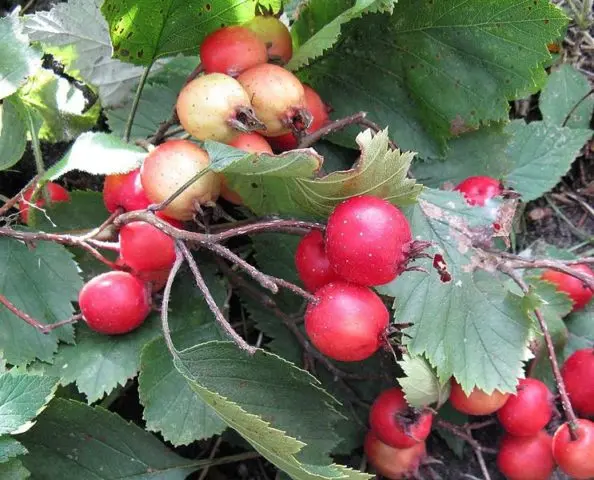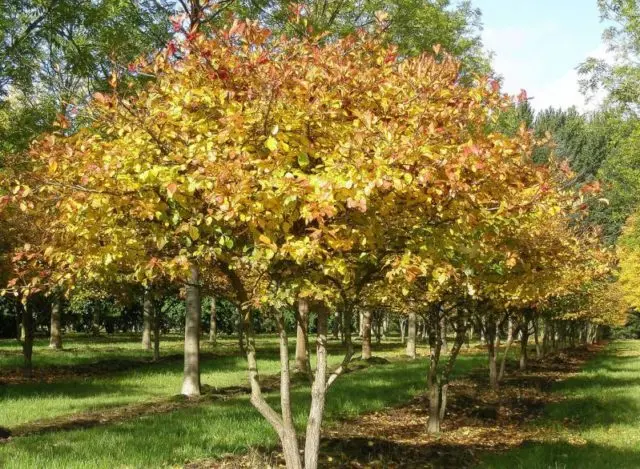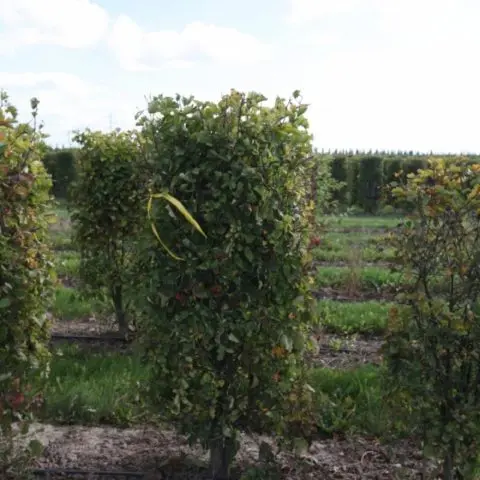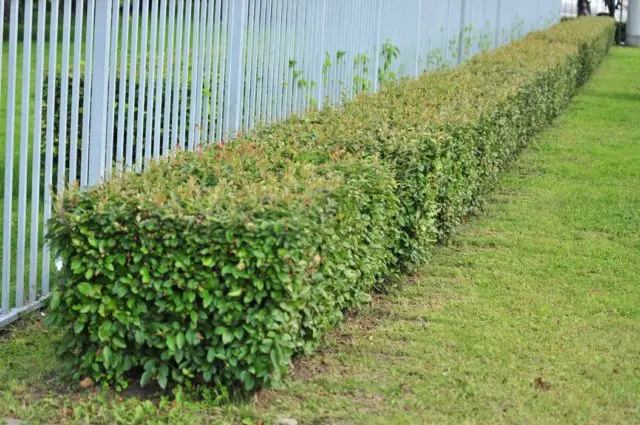Contents
Hawthorn Rooster spur is the leader among other varieties in terms of the size of the spines. The plant gets its name from its long, curved, sharp shoots. Therefore, when forming a hedge, it has no equal. However, this variety is not only valuable. Cock spur is an unpretentious and durable type of hawthorn.

History of breeding
The natural habitat of the cockspur hawthorn variety is the southern territory of Canada and the American states: North Carolina, Kansas. The plant can be found on forest edges, river banks, mountain slopes, in valleys. In 1656, the cockspur hawthorn began to be cultivated in Our Country and Western Europe. It grows successfully in the Baltic States, Ukraine, Lipetsk and Voronezh regions, in colder regions there are cases of freezing. In Central Asia, it requires additional watering.
Description of hawthorn Cockspur
Hawthorn Cockspur is a small tree, up to 12 m in height. Most often found as a large shrub. The crown is densely branched, spherical in shape, which is set low, almost flat. Branches grow horizontally, bare, zigzag. The color of the shoots is reddish-brown with a brilliant sheen. The trunk diameter is 20-30 cm. The bark is ash-gray with a brown tint. The structure is lamellar.
On the hawthorn cockspur there are numerous thorns 3-10 cm long. On older branches, the spines are branched, growing up to 20 cm.
The foliage is ovate or oval, with 3 or 4 pairs of lobes. Leaf size 4-10 cm long and up to 3 cm wide. The base is truncated, broadly wedge-shaped. The top is pointed. The leaves are at first strongly lowered, gradually becoming bare. Over time, pubescence remains only on the veins. On the edge of the foliage has a jagged border. In summer, the leaves are leathery, dark green with a glossy sheen. In the autumn season, they are colored red or orange. Petiole 1-2 cm long.
Hawthorn variety Cockspur blooms in large inflorescences of 12-15 flowers. They do not have pubescence. The size of the corolla in diameter is 1,5 cm. The sepals are red, triangular-lanceolate in shape. When the fetus is bent down. Stamens 10 pieces.
The fruits of the hawthorn variety Petushya spur are spherical, greenish-brown, at the time of ripening they acquire a pale red color with a slight bluish bloom. The pulp is somewhat dryish, dense, orange in color. Ripened fruits have a tart, astringent taste. They remain on the tree throughout the cold season.

Characteristic of the variety
Hawthorn Cockspur has a number of different decorative forms:
- nana – almost prostrate shrub;
- angustifolia – with graceful linear-lanceolate leaves;
- thornless – shoots are devoid of thorns;
- large-fruited – with brightly colored fruits up to 2,5 cm in diameter.
Drought and frost resistance
The hawthorn Cockspur has a relative winter hardiness. Frost resistance zone “5a”. In cold areas, shelter is required for the winter. Meanwhile, the plant tolerates urban conditions, air pollution well. The variety is wind resistant. Hawthorn Rooster spur is drought-resistant, does not require additional watering.
Yield and fruiting
The flowering period of the hawthorn variety Cockspur begins in June. The fruiting period begins in September-October. Ripe berries have a rich, persistent aroma. Suitable for eating. Jelly is prepared from the fruits of the hawthorn Cockspur, compotes, jelly are cooked, dried, fresh berries are eaten.
Disease and pest resistance
The main enemies of the hawthorn variety Cockspur are; apple and comma-shaped worms – affect branches and trunk; apple aphid, psyllid, apple sucker, hawthorn, ringed silkworm, peeled off – harm the foliage. The most acute hawthorn Rooster’s spur tolerates diseases of powdery mildew and leaf rust.
Advantages and disadvantages
The hawthorn variety Cockspur, like other varieties of this family, has certain strengths and weaknesses. The advantages should include:
- drought tolerance;
- undemanding to the growing environment;
- resistance to diseases and pests;
- regular fruiting;
- suitable for hedges;
- resistant to gas pollution and strong winds.
Disadvantages:
- slow growth of seedlings;
- the first fruiting occurs at the age of 10-15 years;
- does not tolerate pruning;
- bark with thorns;
- relative frost resistance.
Features of landing
Hawthorn variety Cockspur is a non-capricious plant, it can grow in any conditions. The main thing is to correctly perform the landing procedure. Compliance with all the nuances will allow the culture to maintain decorative durability up to 40-50 years:

Recommended timing
Hawthorn variety Cockspur is recommended to be planted in autumn, during the period of leaf fall. However, spring planting is also acceptable. Only shrubs need to be planted before sap flow begins.
Planting in the fall is considered more successful. Before frost, the root system is able to get stronger, adapt to the new soil. During the winter, gaining strength for the further process of vegetation. As a rule, a tree planted in autumn already blooms in spring.
Selecting a suitable site and soil preparation
Hawthorn Rooster’s spur develops better, blooms profusely and bears fruit in well-drained, sandy or loamy soils. Do not forget also about the sunlight, which should be a lot on the site. Meanwhile, the plant is able to grow in partial shade. Open, wind-sheltered areas are best suited.
In group planting, hawthorns are planted at a distance of 2-5 m, and in alleys – 5-6 m. The best age for planting a tree in a permanent place is 3-5 years old, older plants suffer quite a lot from transplantation.
Before planting, fertilize the soil in advance. To seal the pit, soddy soil, humus, peat and sand are combined in proportions of 2: 2: 1: 1. In addition, manure and the top of the soil can be added to the planting mixture. Desired soil acidity pH 7,5-8. It is worth noting that the soft hawthorn has a highly branched, powerful, long root system. This factor must be taken into account when forming a recess.
What crops can and cannot be planted nearby
Living, well-formed hedges are preferred to be planted at the border of the plots. But for fencing orchards where pears or apple trees are planted, hawthorn of the Cock Spur variety cannot be used. Since these plants have the same pests, and such an action will make subsequent pest control more difficult.

Selection and preparation of planting material
For planting, it is desirable to choose 2-3-year-old seedlings. Their height depends on the type of planting: seedlings 1-1,5 m high are suitable for a two-row hedge, larger ones are needed for a single-row hedge. It is important that plants have an equally developed root system and aerial part. If it is planned to plant free-standing trees, then planting material should be up to 2 m in height and under 5 years old.
Before planting, the lateral branches and the top are shortened by ½ of the growth length at the cockspur hawthorn seedling, aligning with the total length of the plant. Remove broken roots, cut too long.
Landing algorithm
- In the selected area, dig a hole measuring 70×70 cm.
- A drainage layer of broken brick, crushed stone or expanded clay, 15 cm thick, is laid at the bottom of it.
- 30-40 g of lime or 50 g of phosphate rock are also sent to the pit.
- A hawthorn seedling of the Cock Spur variety is placed in the center of the recess and sprinkled with earth. The root neck is not deepened much, it should be 3-5 cm above the ground.
- The earth around the roots is carefully poured and rammed.
- At the end, you need to water the young hawthorn Cockspur with warm water.
- At the end of planting, the near-stem circle is mulched with peat.

Aftercare
Hawthorn variety Cockspur is easy to care for. Only simple rules and preventive measures are applied.
Hawthorn variety Cockspur is a drought-resistant plant. In cool weather, it will be enough to pour 10 liters of water under the bush. This volume is enough not to water it at all for a month, since excess moisture can lead to rotting of the roots and death of the plant itself. On hot days, Hawthorn Cockspur needs to be moistened up to 3 times a month.
After moistening, loosen the soil to a depth of 15 cm. Weeds should be removed regularly. In autumn, dig a plot around the perimeter of the crown.
In early spring, preventive pruning is carried out, removing dry, diseased, damaged branches. The tree is thinned out, providing access to air and light. Branches growing upwards are also shortened.
Shrub varieties of hawthorn Cockspur can ruin severe frosts. In places with a harsh climate, it is recommended to shelter the root system. For this, as a rule, a mulching layer of hay, straw, dry leaves is used. The near-stem circle is covered with a layer 10-15 cm thick.
For proper development and obtaining a decent harvest of berries, the Cockspur hawthorn variety must be nourished. It is recommended to fertilize 2 times per season. The first time in early spring before the start of the growing season, using nitrophoska. The second time – during flowering, use slurry, 8 liters under a tree.
Diseases and pests, methods of control and prevention
To maintain decorative qualities and obtain abundant flowering in the hawthorn of the Cockspur variety, it is necessary to identify lesions in a timely manner and take measures to eliminate them. Pest control includes:
- treatment with soap, tobacco solution – from aphids, scale insects;
- 0,1% metaphos, 0,3% karbophos – from apple schitovy, leaf blocks, silkworm;
- colloidal sulfur solution saves from ticks and hawthorn.
Fungal diseases are best treated by spraying with systemic fungicides.

Application in landscape design
Hawthorn variety Cockspur has an attractive appearance all year round. In spring they delight with delicate flowering, in summer – fruits with a variety of colors, in autumn the foliage changes shades, becoming red, orange, yellow, in winter – a compact crown. The shrub is often used as a hedge, thanks to its long thorns and good tenacity. Planted as single trees or in groups. Hawthorn Cockspur looks great as an element of landscape composition for alley plantings, forest sparse plantings.
Conclusion
Hawthorn Rooster spur is widely used for landscaping city parks, squares, home gardens. And this is no accident, since the plant is durable, undemanding to the composition of the soil, drought-resistant, decorative. A number of useful qualities provide him with well-deserved popularity.









